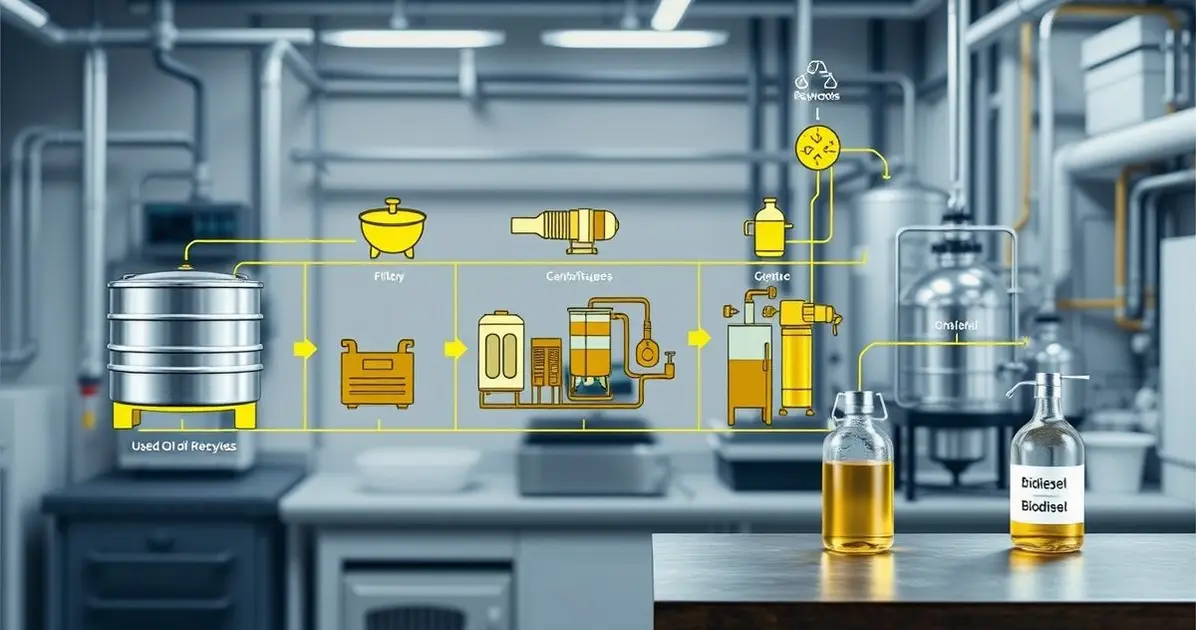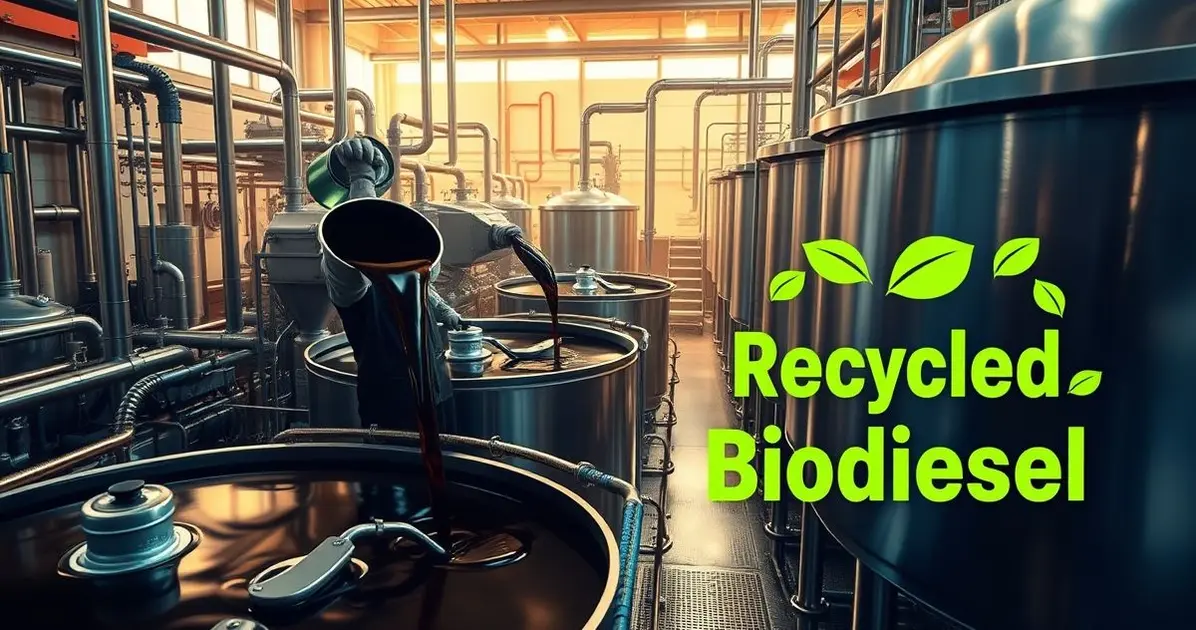Recycling cooking oil is a vital process that turns waste into resources. By repurposing used cooking oil, we can create biodiesel and reduce environmental impact, promoting sustainability in energy production.
How cooking oil is recycled

The recycling of cooking oil involves collecting used oil from kitchens, cleaning and purifying it, and converting it into biodiesel. This process not only helps reduce waste but also contributes to renewable energy, showcasing a sustainable approach to cooking oil disposal.
The Journey of Used Cooking Oil
The journey of used cooking oil is an important process that highlights how this common kitchen waste can be transformed into valuable resources. Here’s a detailed look at the steps involved in the journey of used cooking oil:
1. Collection: The journey begins with the collection of used cooking oil from various sources. Restaurants, cafes, and food processing facilities often have designated containers for collecting oil after frying or cooking. Home cooks can also participate by saving their used oil in a container for recycling. Proper collection is crucial for ensuring that the oil is gathered efficiently and in large quantities.
2. Transportation: After collection, the used cooking oil is transported to recycling facilities. This step is essential to ensure that the oil is processed quickly to prevent degradation. Transportation methods vary depending on the volume of oil collected, and it is typically done using specialized vehicles that can safely carry large quantities of liquid.
3. Filtration and Cleaning: Upon arrival at the recycling facility, the used cooking oil undergoes a thorough filtration and cleaning process. This involves removing food particles, contaminants, and impurities that may have accumulated during cooking. Filtration can be achieved through various methods, including the use of fine mesh screens, centrifugation, or chemical treatments to ensure the oil is clean and ready for further processing.
4. Processing: Once the oil is filtered, it is subjected to processing techniques that convert it into usable products. One common method is transesterification, where the oil is chemically transformed into biodiesel. This process involves mixing the oil with an alcohol (usually methanol) and a catalyst to create biodiesel and glycerin. The biodiesel can then be used as a renewable energy source for vehicles and machinery.
5. Repurposing: In addition to biodiesel production, recycled cooking oil can be repurposed for various applications, including the production of soaps, lubricants, and even animal feed. This versatility showcases the potential of used cooking oil to contribute to multiple industries and reduce waste.
6. Environmental Impact: The journey of used cooking oil plays a significant role in reducing environmental pollution. By recycling cooking oil, we divert it from landfills and prevent the harmful effects of improper disposal, such as water contamination. Additionally, the production of biodiesel from recycled oil helps decrease reliance on fossil fuels, contributing to a cleaner environment.
In summary, the journey of used cooking oil involves several critical steps from collection to processing and repurposing. Understanding this journey emphasizes the importance of recycling and how individuals and businesses can contribute to a more sustainable future by participating in cooking oil recycling initiatives.
Recycling Methods: Filtration and Processing Techniques
Recycling used cooking oil involves several methods, primarily focusing on filtration and processing techniques that ensure the oil is purified and transformed into usable products. Here’s a closer look at these recycling methods:
1. Filtration: The first step in recycling cooking oil is filtration, which is crucial for removing impurities, food particles, and contaminants that accumulate during cooking. This process typically involves:
- Mechanical Filtration: This method uses fine mesh screens or filters to physically separate solid particles from the liquid oil. It’s effective for removing larger debris and is often the initial step in the recycling process.
- Centrifugation: Centrifugation is a more advanced filtration technique that uses centrifugal force to separate components based on density. This method is effective for removing smaller particles and can enhance the purity of the oil.
- Chemical Filtration: In some cases, chemical agents may be used to bind with impurities, making them easier to remove during the filtration process. This method can improve the overall quality of the recycled oil.
2. Processing Techniques: After filtration, the recycled oil undergoes various processing techniques to convert it into usable products. Key processing methods include:
- Transesterification: This is a chemical process that converts used cooking oil into biodiesel. The oil is mixed with an alcohol (typically methanol) and a catalyst, which results in the formation of biodiesel and glycerin. Biodiesel can be used as a renewable energy source for vehicles and machinery.
- Hydrogenation: In some cases, the oil may undergo hydrogenation, a process that adds hydrogen to the oil to stabilize it and improve its shelf life. This method can also alter the oil’s properties, making it suitable for different applications.
- Deodorization: To remove any undesirable odors that may have developed during cooking, the oil may be deodorized. This process typically involves heating the oil under vacuum conditions, which helps eliminate volatile compounds responsible for off-odors.
3. Quality Control: Throughout the filtration and processing stages, quality control measures are implemented to ensure that the recycled oil meets safety and quality standards. This may include laboratory testing for purity, acidity levels, and the presence of contaminants.
In summary, the recycling methods for used cooking oil involve a combination of filtration and processing techniques designed to purify the oil and convert it into valuable products like biodiesel. By employing these methods, we can effectively recycle cooking oil, reduce waste, and contribute to a more sustainable environment.

Environmental Benefits of Recycling Cooking Oil
Recycling cooking oil offers numerous environmental benefits that contribute to sustainability and the reduction of waste.
Here are some key advantages:
1. Reducing Landfill Waste: One of the most significant environmental benefits of recycling cooking oil is the reduction of waste sent to landfills. When used cooking oil is properly recycled, it prevents the oil from being discarded in landfills, where it can take years to decompose and contribute to environmental pollution.
2. Preventing Water Pollution: Improper disposal of cooking oil can lead to water pollution when it enters drainage systems or waterways. Recycling used cooking oil helps prevent this pollution, protecting aquatic ecosystems and ensuring cleaner water sources.
3. Producing Renewable Energy: Recycling cooking oil into biodiesel provides a renewable energy source that can replace fossil fuels. Biodiesel produced from recycled oil emits fewer greenhouse gases compared to traditional diesel, contributing to a reduction in carbon emissions and improving air quality.
4. Promoting a Circular Economy: Recycling cooking oil supports the principles of a circular economy, where resources are reused and repurposed rather than discarded. This approach encourages sustainable practices and reduces the demand for new raw materials, leading to less environmental impact.
5. Conserving Resources: By recycling cooking oil, we conserve natural resources that would otherwise be used to produce new oils. This not only reduces the environmental footprint associated with oil extraction and production but also promotes more efficient use of existing resources.
6. Supporting Local Economies: Recycling initiatives often support local businesses and create jobs in the recycling and biodiesel industries. By participating in cooking oil recycling programs, individuals contribute to local economic growth while promoting sustainable practices.
In summary, recycling cooking oil provides significant environmental benefits, including reducing landfill waste, preventing water pollution, producing renewable energy, and promoting a circular economy. By recycling used cooking oil, we can contribute to a healthier planet and support sustainable practices that benefit both the environment and our communities.
Promoting a Circular Economy through Cooking Oil Recycling
Promoting a circular economy through cooking oil recycling is an essential aspect of sustainable practices that benefits both the environment and society. Here’s how recycling used cooking oil contributes to this concept:
1. Definition of Circular Economy: A circular economy is an economic system aimed at eliminating waste and the continual use of resources. It contrasts with the traditional linear economy, which follows a ‘take, make, dispose’ model. In a circular economy, products and materials are reused, repaired, and recycled to create a closed-loop system.
2. Reusing Resources: Recycling cooking oil exemplifies the principles of a circular economy by transforming waste into valuable resources. Used cooking oil can be converted into biodiesel, which serves as a renewable energy source. This process not only reuses the oil but also reduces the demand for new fossil fuels, promoting resource efficiency.
3. Reducing Environmental Impact: By recycling cooking oil, we minimize the environmental impact associated with waste disposal and resource extraction. Cooking oil that would otherwise contribute to pollution when discarded is repurposed, helping to reduce landfill waste and prevent water contamination.
4. Encouraging Sustainable Practices: Cooking oil recycling encourages individuals and businesses to adopt more sustainable practices. As more people become aware of the benefits of recycling, they are likely to engage in other eco-friendly behaviors, reinforcing the principles of a circular economy in their daily lives.
5. Supporting Local Economies: Recycling initiatives often create local jobs and support businesses involved in the collection, processing, and distribution of recycled products. By participating in cooking oil recycling programs, communities can strengthen their local economies while contributing to sustainability efforts.
6. Educating Communities: Promoting cooking oil recycling raises awareness about the importance of sustainability and the circular economy. Educational campaigns can inform the public about how their actions, such as recycling cooking oil, contribute to a larger movement toward environmental responsibility.
In summary, promoting a circular economy through cooking oil recycling plays a vital role in minimizing waste, reusing resources, and reducing environmental impact. By embracing this practice, individuals and communities can contribute to a sustainable future that benefits both the planet and society.
Conclusion
In conclusion, recycling cooking oil is a vital practice that not only benefits the environment but also supports the principles of a circular economy. By understanding the journey of used cooking oil—from collection to transformation into valuable resources like biodiesel—we can appreciate the importance of this process in reducing waste and conserving resources.
Through effective recycling methods such as filtration and processing techniques, we can ensure that used cooking oil is repurposed safely and efficiently. The environmental benefits of recycling, including reducing landfill waste and preventing water pollution, highlight the positive impact that this practice can have on our planet.
Moreover, promoting a circular economy through cooking oil recycling encourages sustainable practices, supports local economies, and raises awareness about the importance of reusing resources. By participating in cooking oil recycling initiatives, individuals and communities can contribute to a healthier environment and a more sustainable future.
Ultimately, embracing the recycling of cooking oil is a step toward responsible consumption and environmental stewardship. Together, we can make a significant difference in creating a greener planet for future generations.
FAQ – Frequently Asked Questions about Recycling Cooking Oil
How is cooking oil recycled?
Cooking oil is recycled through a process that includes collection, filtration, and processing techniques to convert it into biodiesel and other products.
What are the environmental benefits of recycling cooking oil?
Recycling cooking oil reduces landfill waste, prevents water pollution, produces renewable energy, and promotes a circular economy.
What methods are used to filter and process used cooking oil?
Common methods include mechanical filtration, centrifugation, and transesterification to convert the oil into biodiesel.
How does recycling cooking oil support a circular economy?
Recycling cooking oil promotes a circular economy by reusing waste materials, reducing environmental impact, and encouraging sustainable practices.
Can I recycle cooking oil from home?
Yes, many communities have recycling programs for used cooking oil. Check with local waste management or recycling facilities for drop-off options.
What types of cooking oil can be recycled?
Most types of used cooking oil, including vegetable oil, canola oil, and olive oil, can be recycled, but check with local facilities for specific guidelines.
See more
Discover plenty of easy and delicious recipes you can make at home, from hearty dinners to indulgent desserts and wholesome breakfasts.




